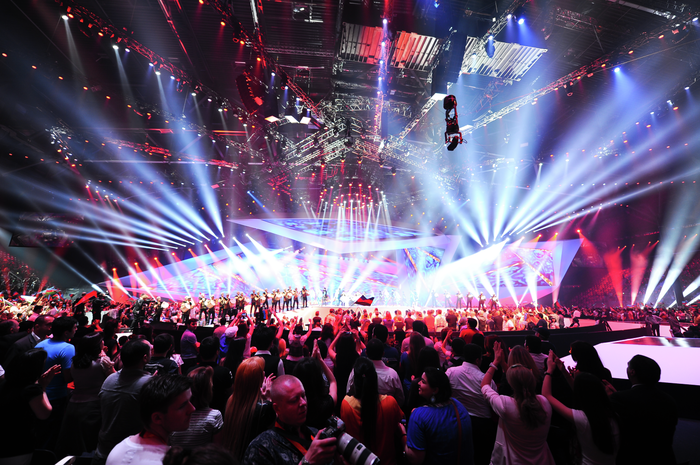Alive 2007: How Daft Punk let their music do the talking
Following the French duo’s split, columnist Faiz Ghaffar explores the link between the EDM pioneers’ music and their distinctive image

Daft Punk was the last couple you’d expect to break up over lockdown. Yet just two months ago, Guy-Manuel de Homem-Christo detonated Thomas Bangalter. A breakup interview now feels like it would’ve been an infinite improvement. At least with an interview, you can reassure yourself that the couple might preserve some friendship, but there’s little solace to be found in an explosion. The industry’s favourite robots are gone for good: one has been reduced to ashes; the other is currently strolling off into the sunset, and not a word was said about it. It still feels surreal. Yet it is true to the Daft Punk philosophy that countless fans and critics fell in love with: letting the music do the talking.
“The helmets eventually became a statement. “We don’t believe in the star system. We want the focus to be on the music,” explained Bangalter”
Across the duo’s genre-defying discography, that philosophy was one of the few things that stayed constant. You only need to look at Daft Punk’s iconic helmets to understand it. Although the duo initially hid their faces to protect their privacy, the helmets eventually became a statement. “We don’t believe in the star system. We want the focus to be on the music,” explained Bangalter . It is easy to see where he is coming from. With stories about Lady Gaga donning a meat dress or the Weeknd flaunting facial prosthetics attracting all the headlines, you can be forgiven for forgetting the songs they were originally promoting. It’s not as though abstinence from visual expression is some virtue that all musicians should pursue. Daft Punk themselves are no strangers to mind-bending live performances or avant-garde music videos. However, they ensured that these never distracted from the music itself. The result was a style that was refreshingly cohesive and classy. Yet, the greatest strength of letting the music do the talking is that, occasionally, the music says far more than words could express.
The duo’s third studio album, Human After All, was met with negative reception from fans and critics alike. Pitchfork panned the album, describing its defining characteristic as a lack of ‘wonderment or joy’. Over the following year, fans began to lose faith as well. Gone was the quirky delight found in songs like “Around the World” and “One More Time”, which had altogether been replaced by the cold, mechanical riffs of “The Brainwasher” and “Television Rules the Nation”. Daft Punk appeared to be a sinking ship. Yet, where Eminem would have bitched about critics in his next album, or where Selena Gomez would have begged her fans to stream it, Daft Punk remained quiet. That was until Coachella 2006.
“Daft Punk’s synths scream in fury as a distorted voice proclaims, “I AM THE BRAINWASHER”. It’s music on a mission”
After an hour and a half atop a giant LED pyramid, Daft Punk ridiculed anyone who had doubted them. Although only ancient, low quality YouTube videos give a sense of what the performance really looked like, the entire set list is available as a live album, Alive 2007. On the opener, “Robot Rock / Oh Yeah”, glitchy noises slowly transform into the words “human” and “robot” asking the question: who are Daft Punk, really? It’s not long before the track crescendos with teasing hi-hats and pulsing bass into the thunderous riff of “Robot Rock”. The tenth track, “Prime Time of Your Life / Brainwasher / Rollin’ & Scratchin’” is a colossal, ten minute track of even greater ferocity. Two minutes into the song, Daft Punk’s synths scream in fury as a distorted voice proclaims, “I AM THE BRAINWASHER”. It’s music on a mission, remixing the songs which critics trashed on Human After All and blasting them into semi-hypnotic, monster anthems.
It’s not all a lesson in humility though. Alive also features fan favourites remixed in ways fans didn’t know they needed. “Around the World / Harder Better Faster Stronger” and the closing track, “Human After All / Together / One More Time / Music Sounds Better With You” are matches made in heaven. It’s probably the closest dance music comes to recreating the feeling of introducing eccentric friends to each other who go on to have enviable chemistry. On “Face to Face / Short Circuit”, Alive even pulls off a love song, with a blissful synth outro which feels like a place to catch your breath in the tracklist.
In short, Alive is the sound of a comeback. A comeback that even Michael Jordan could be jealous of. It said more than any angry tweet or open letter could ever dream of expressing. And it’s a fantastically enjoyable reminder to musicians as to why they should let the music do the talking. While the robots will be sorely missed, we might find some solace after all in the fact that the philosophy of Daft Punk will endure.
 Features / Should I stay or should I go? Cambridge students and alumni reflect on how their memories stay with them15 December 2025
Features / Should I stay or should I go? Cambridge students and alumni reflect on how their memories stay with them15 December 2025 News / Cambridge study finds students learn better with notes than AI13 December 2025
News / Cambridge study finds students learn better with notes than AI13 December 2025 Comment / The magic of an eight-week term15 December 2025
Comment / The magic of an eight-week term15 December 2025 News / News In Brief: Michaelmas marriages, monogamous mammals, and messaging manipulation15 December 2025
News / News In Brief: Michaelmas marriages, monogamous mammals, and messaging manipulation15 December 2025 News / Uni Scout and Guide Club affirms trans inclusion 12 December 2025
News / Uni Scout and Guide Club affirms trans inclusion 12 December 2025










